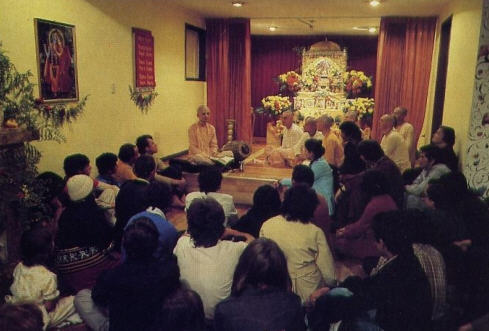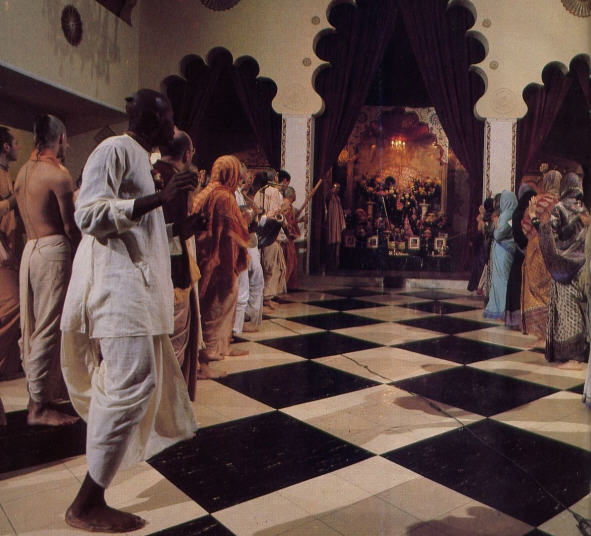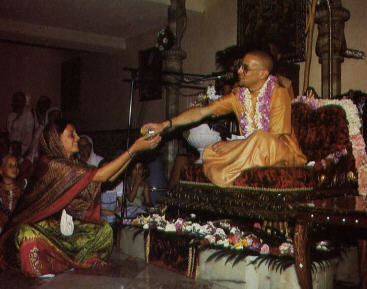Krsna is a Sanskrit name for God. Literally, Krsna means "the all-attractive one." And Krsna consciousness means the day-to-day awareness of our eternal relationship with Krsna. The technical term for Krsna consciousness is bhakti-yoga, or the yogaof devotion. There are many kinds of yoga, or means for linking oneself with the Supreme. Karma-yoga, or sacrifice of the fruits of work, leads to jnana-yoga, or knowledge of the difference between matter and spirit. This leads to astanga-yoga, by which one develops mystic powers through meditation. But of all yoga practices bhakti is the highest, because it is nothing less than the eternal activity of the soul after liberation from the material world. When the soul leaves the material body, all other yogapractices end, but bhakti, being the very nature of the soul, continues without end.
Many people practice modern versions of yoga exercise to achieve better health or digestion, or a better sex life, or to subdue mental stress. These "updated" forms are not, however, real yoga. The word yoga means "linking with the Supreme." and the rules governing proper yoga exercises are so rigorous as to be nearly impossible in the present age. Even Arjuna, the hero of the Bhagavad-gita, rejected the austere physical disciplines of such yoga as impractical for him. Krsna then informed him that these difficult practices would be unnecessary if he simply took up devotional yoga: "Of all yogis, he who always abides in Me with great faith, worshiping Me in transcendental loving service, is most intimately united with Me in yoga and is the highest of all." (Bhagavad-gita, 6.47)
Five hundred years ago, Krsna appeared as Sri Caitanya Mahaprabhu to demonstrate how to perform bhakti-yoga. At different moments in history, the Supreme Lord appears, either in person or else represented by His pure devotee, to deliver a means of self-realization appropriate to a particular culture and environment. Every true avatara, or appearance of the Supreme Lord, is recorded in advance, and without scriptural confirmation no one can be accepted as an avatara of God. More than four thousand years before the advent of Sri Caitanya, His appearance and mission were described in the Vedic texts. His teachings, now being carried forward by the International Society for Krishna Consciousness (ISKCON), were brought to the West in 1965 by His Divine Grace A.C. Bhaktivedanta Swami Prabhupada, ISKCON's Founder-Acarya. * [*Acarya: one who teaches by example as well as by precept.]
Coming to Know Krsna

Sri Caitanya Mahaprabhu's disciples compiled an extensive literature on the practice of bhakti-yoga. Their books describe that hearing (in Sanskrit, sravana) is the most effective means for imbibing a sense of devotion to Krsna. Many people therefore begin cultivating their Krsna consciousness by attending the classes on the Bhagavad-gita and other texts held daily in Krsna temples. One needs no previous qualifications in yoga to hear about Krsna. Krsna's activities and personal qualities are so attractive that anyone who simply hears about them receptively will discover a natural affinity for Krsna and His devotional service.
To be effective, of course, hearing demands not only that the hearer be receptive to the message but also that the speaker transmit the teachings purely. That is why, for example, when a devotee lectures in public he takes great, care to present faithfully what he has learned from his spiritual master. Invented ideas about the Absolute Truth have little value; opinions are, after all, as individual as their authors. Knowledge of God, on the other hand, has remained unchanged since the time Krsna first spoke the Vedic sciences to Brahma at the dawn of creation. Brahma, architect of the material universe, in turn transmitted the Vedic teachings to his disciples, who then taught their disciples, and so on down through the ages. This method of teaching is calledparampara, or the system of descending knowledge (as opposed to ascending knowledge, that which is achieved through empiric research).
This parampara system forms the foundation of the Krsna consciousness movement. How has Krsna consciousness spread around the world so quickly? Why, of all the translations of Bhagavad-gita, did Srila Prabhupada's edition alone inspire an international movement of devotion to Krsna? The answer is parampara. Only Srila Prabhupada's edition presents the unaltered teachings of Krsna, as relayed by the parampara system. In every other English translation the commentator uses the Gita as a vehicle for his own philosophy. But Srila Prabhupada, as a pure devotee of Krsna, was motivated only to awaken people's natural love for Krsna. He acted as a message carrier, not as an interpreter or philosopher. The explanations received from theparampara are sufficient for reviving God consciousness; they need no additions or interpretations. The Krsna consciousness movement has grown because it is nourished by the pure teachings of Lord Krsna, and Srila Prabhupada's disciples are carrying on that pure heritage.
Chanting Hare Krsna
For previous ages, when people lived much longer and could concentrate better than today, the Vedic texts recommended solitary meditation and physical yoga practice as means to achieve self-realization. But for most people today, of course, such methods are impossible. It would be unreasonable to expect a married man with business responsibilities to abandon his work and family for the austere life of a recluse. Rather, for this age the Vedas recommend the chanting of God's holy names: Hare Krsna, Hare Krsna, Krsna Krsna, Hare Hare/ Hare Rama, Hare Rama, Rama Rama, Hare Hare. The chanting of this mantra (spiritual sound) has the same purifying influence as associating directly with Krsna. Since God is absolute, He and His name are nondifferent. When we utter ordinary material sounds, like "water" or "light," they themselves have no substance; their value lies in the meaning they convey. A material sound is different from the idea it represents. On the spiritual platform, however, no distinction separates a sound from its meaning. And so the name Krsna possesses the same purifying qualities as Krsna Himself.

What are those purifying qualities? The Vedas compare them to the influence of the sun on a puddle of urine. Just as the sun evaporates the liquid, eliminates the obnoxious smell, and renders the spot clean without itself ever becoming contaminated so the name of Krsna acts like a spiritual sun to clean away the contamination of material qualities like lust and greed and to reveal the soul hidden within.
Chanting is a simple process that can be performed anywhere, under any circumstances, and even an inexperienced chanter can realize immediate results. The first result of chanting is an abatement of material anxieties. Formerly one had to withdraw to the woods or mountains and practice severe penances to achieve full detachment from material anxieties. In the present age, however, the same result is available through chanting. Devotees chant in two ways: either soto voce, as a personal meditation, while turning sacred beads called japa-mala, or congregationally, in the temple or at home or in public.
The japa-mala strand consists of 108 beads, each separated from the next by a small knot. An additional bead, somewhat larger, is the starting point. One does not chant on this bead; rather, it serves to indicate when one has finished each "round" of 108 beads. A chanter turns each bead between thumb and forefinger while reciting the Hare Krsna mantra. Then he moves on to the next bead and again recites the mantra. At the end of each round, the chanter begins the next round in the opposite direction, rather than crossing over the large bead.
An initiated devotee, or one aspiring for initiation, chants at least sixteen rounds daily. Rounds take six or seven minutes each, or a daily total of an hour and a half to two hours.
Sankirtana, or public chanting of the holy names, was introduced by Sri Caitanya Mahaprabhu in Bengal at the turn of the sixteenth century. He promulgated public chanting as the highest welfare activity and the religious duty for the present age. Both the street chanting that devotees perform in cities and towns around the world and the japa chanting are full of spiritual potency. Japa meditation, however, engages only the tongue and the ear of the chanter, whereas sankirtana has the added advantage of benefiting all who hear the chanting, and it also engages the entire body in dance, which takes place as a natural part of congregational chanting.
The basic principle of Krsna consciousness is remembering Krsna. And that is why devotees regularly chant the Hare Krsna mantra. In the beginning, a candidate for spiritual initiation may not be prepared to chant sixteen rounds daily. If not, he should determine some smaller number two or three rounds, for example that he will chant without fail. It is better to chant regularly than sporadically three rounds every day is better than ten rounds one day and none the next. Progressively, as one continues to chant, one will naturally develop a desire to adopt the other principles and practices of bhakti-yoga.
The Morning Program

A Krsna devotee is careful to maintain internal and external purity as protection against the conditioning that impedes spiritual growth. So upon using in the morning, a devotee recites the holy names of the Hare Krsna mantra for internal purity and bathes for external purity. The Bhagavad-gita also describes that one cannot become successful in yoga if one eats or sleeps too much or too little. The Vedic scriptures therefore recommend not more than six hours rest at night for those seeking spiritual advancement. One can better progress spiritually if one takes rest early, instead of keeping late hours engaged in materialistic activities, and if one does not eat heavily at night.
For one aspiring to self-realization, the hours preceding sunrise, which are called brahma-muhurta, are particularly auspicious. Devotees generally rise by 3:30 a.m. to attend the first ceremony of the day, mangala-arati, during which they greet the Krsna Deity* [* The Deity is a manifestation of Krsna's personal form, fashioned from elements such as marble or wood. Krsna appears in the Deity form to facilitate the service of His devotees.] and offer varieties of gifts such as incense, flowers, and foods. Devotees who live too far away to attend morning ceremonies in the temple rise early and perform the same offering at home, meditating before a simple altar that bears a photo of the spiritual master (guru) and a painting of Sri Caitanya (Gauranga), surrounded by His principal associates, called collectively the Panca-tattva. Whether at home or in the temple, these daily services, held during the peaceful morning hours and accompanied by the sweet melodies of arati and the pleasing vision of the Deity or guru-Gauranga altar, awaken in the neophyte a sense of his eternal relationship with Krsna.
The activities so far described are important for cultivating bhakti-yoga. If the candidate for devotional service wants to advance steadily, however, he must also follow four regulative principles that constitute the pillars of devotional life.
The Diet

The first regulative principle is no meat, fish or eggs in the diet. Meat-eating is the single greatest obstacle to spiritual progress. Fish are also considered animal life, and eggs undeveloped animal life. Despite popular opinions to the contrary, no scripture in the world encourages meat-eating, although some concessions may be mentioned for persons unable to control their tongues. Even then, however, the Vedas strictly prohibit cow-killing. The Vedic culture considers the cow a mother to human society because she supplies us her milk, and it encourages cow protection as essential to a peaceful society. Milk stimulates the growth of the healthy brain tissues required for understanding the finer points of spiritual life. Meat, on the other hand, contains large quantities of toxins and cholesterol that dull perceptions and make spiritual progress nearly impossible. * [* See Back to Godhead Vol. 15, No. 1-2.]
Becoming a vegetarian is not in itself the goal. To make spiritual progress one must offer his food to the Supreme Lord with love and devotion. In preparing a meal, the devotee remembers that the offering is meant for Krsna's pleasure, not his own. This does not decrease the satisfaction of eating; rather, the pleasure is increased by the devotional effort and by the fresh ingredients used exclusively in preparing food for offering to Krsna.
All the practices of bhakti-yoga aid in awakening our dormant sense of God consciousness. The devotee therefore follows strict kitchen rules while preparing an offering. The most important rule is never to taste a preparation before it has been offered to Krsna. He must be the first to enjoy. God has no need of our food. He is atmarama, completely self-satisfied. He nonetheless appreciates the love and devotion with which His devotee prepares an offering. The more one centers one's thoughts on Krsna, the more the offering is a success. This is real yoga: not to give up eating, but rather to sanctify the food one eats by first offering it to Krsna.
No Intoxication
The second regulative principle is no intoxication, by which is meant the use of any substance that exaggerates or dulls perceptions, including coffee, tea, and tobacco as well as alcohol and drugs. Devotees reject anything that impedes progress in devotional life, and certainly stimulants or depressants are bound to affect concentration on spiritual practices. Sometimes people propose that drugs can lead to spiritual exaltation. Authorities in the parampara, however, have always dismissed that idea. Drugs act on the body and mind but have no access to the soul, which transcends matter.
No Illicit Sex
Illicit sex refers not only to sexual relations outside of marriage but also to intercourse within marriage not intended for procreation. This does not mean an artificial renunciation of all sex, but rather its regulation. In the Bhagavad-gita Krsna says that sex with the goal of procreating and raising God conscious children is sacred, for in such consciousness the sex act becomes an offering to Him.
No Gambling
Gambling is simply a waste of time and money. Human life is short. The sage Canakya used to say that a moment of life spent without pursuing self-realization was the greatest loss, for it could not be bought back for all the gold in the world. And that was before inflation.
Initiation

The most important moment for the practitioner of bhakti-yoga. One who has successfully followed the four regulative principles for at least six months, is initiation by the spiritual master. The guru awards initiation when he feels confident that the candidate has shown his or her sincerity and determination to become Krsna conscious. In contrast with the fifteen-minutes-a-day yoga practices available from pseudogurus and swamis, Krsna consciousness is a constant effort to dedicate one's life to the service of God. The spiritual master therefore refrains from awarding initiation to people still addicted to materialistic habits. The act of initiation in essence links the disciple with Krsna through the intermediary of the guru. The guru's duty is to liberate the disciple from repeated birth and death by properly guiding him and instructing him from scripture, and the disciple's duty is to follow lifelong the guru's teachings. It is not necessary to live in a temple to receive initiation, but life at home must follow the same norms as those of the temple community, including rising early, eating only prasada (vegetarian foods offered first to Lord Krsna), and the other principles of sadhana-bhakti (devotional service in practice).
Working for Krsna
Krsna, the Absolute Truth, includes all things, and any talent or skill can be used in His service. An artist can paint scenes of the spiritual world as described in the Vedas. A writer can write articles on the science of bhakti-yoga. An architect can design and build temples, schools, and asramas dedicated to Lord Krsna. A businessman can help propagate Krsna consciousness by printing books or offering professional services. Everyone, in other words, has a part to play in Krsna's devotional service.
When Srila Prabhupada founded the International Society for Krishna Consciousness in 1965, his intention was to make Krsna consciousness available to people on all levels of society. He instructed his disciples, those students who had dedicated their lives completely to the service of Lord Krsna, to treat visiting guests with the greatest respect and courtesy. "Visiting Krsna's temple is visiting the spiritual world," he would say. Sunday open houses at the many Krsna temples around the world have become well attended weekly functions for thousands who practice bhakti-yoga at home. Here friends and newcomers participate in ecstatic arati ceremonies, share in the multicourse free feast, and receive answers to their questions on spiritual life. Whatever one's background, the programs of Krsna consciousness provide common ground for progress along the spiritual path.
